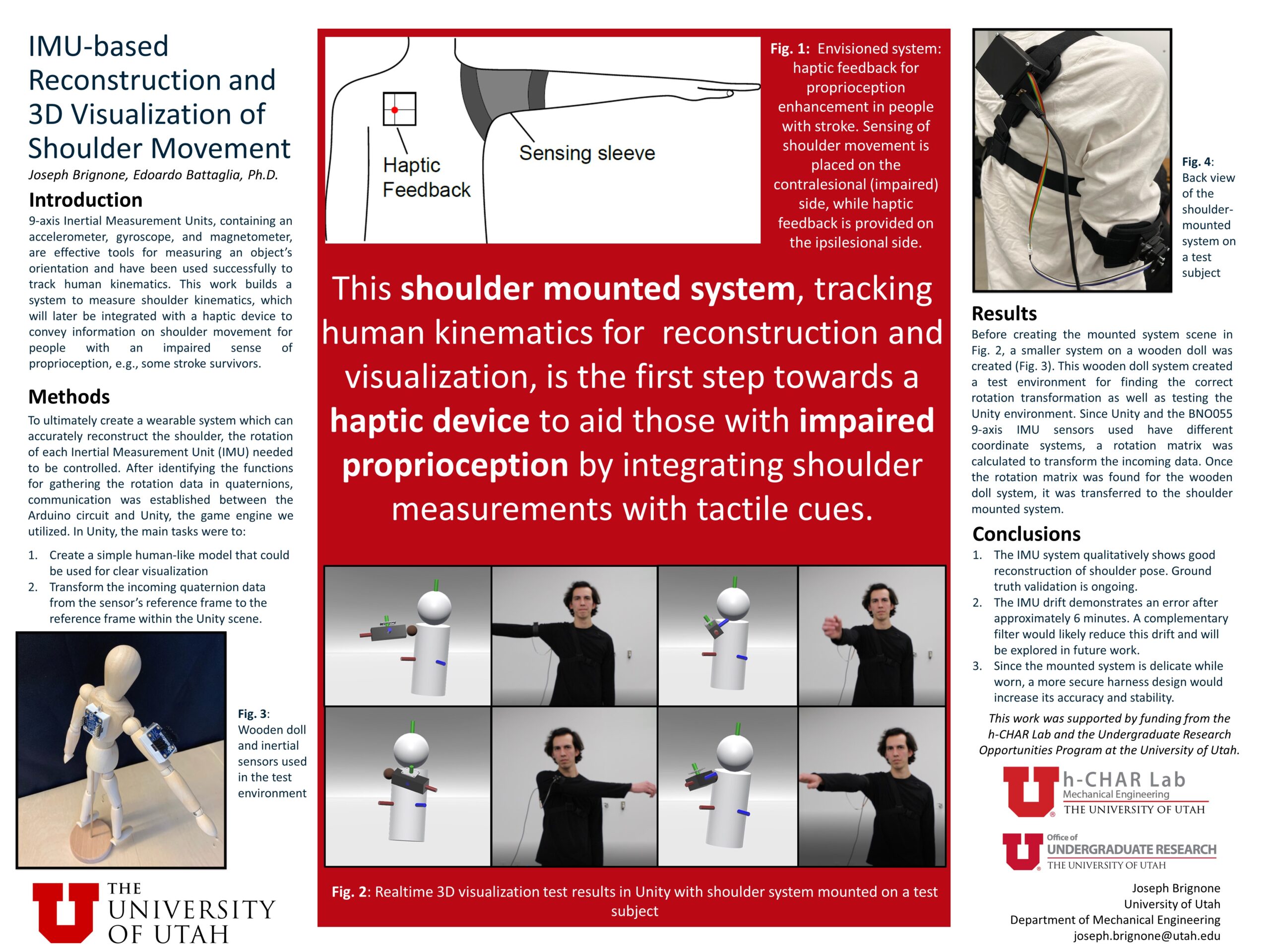Presenter Name: Joey Brignone
Description
Proprioception is the perception of the movement and position of one's own body [1]. The purpose of this study is to improve the proprioception of the shoulder for stroke patients who have lost this sense. Sensory information that allows proprioception comes from Golgi tendon organs, joint and skin stretch receptors, and muscle spindles [2]. Proprioception deficits in the upper extremity are present in about 30% to 48% of stroke patients [1]. This proposed system in this study will measure shoulder movement through Inertial Measurement Units (IMUs) and visualize the movement in real-time. One of these sensors will be placed on the top of the shoulder and the other will be placed near the top of the upper arm, close to the shoulder. The two sensors contain gyroscopes inside of them to measure the rotation of the arm, as well as accelerometers that measure the force of gravity on the sensor. With the rotation angles and speed as the input, these sensors will determine the position and orientation of the arm. The data from this system will later be transferred from the receiving microcontroller to a haptic device to convey these movements to the patient. Before the device is designed, the position and orientation data of the shoulder will be visualized in a 3D model of a mannequin with the inertial sensors attached using Unity 3D. The accuracy of the model will confirm that the data are correct, and the sensors are appropriately capturing the rotations and speed of the shoulder movement. As many patients who lose this sense are unable to regain complete control over their arms, haptic feedback could allow the user to at least partially restore this sense that was lost. This restoration of proprioception should lead patients to more accurate control over their movements. This system would create practical technology for those whose proprioception has been lost or debilitated, as the system should result in a low-cost solution. Proprioception restoration has been researched most commonly for hand movement, and some additional studies have been done on the lower extremity. Since the shoulder has not been the focus of many upper extremity proprioceptive studies, this will enrich the field of study for those creating an extensive system for aiding proprioception. While this research plan focuses on stroke patients, there are other diseases that cause proprioception loss including multiple sclerosis (MS), amyotrophic lateral sclerosis (ALS)/Lou Gehrig's disease, joint injuries, Parkinson's disease, and Huntington's disease. Medical research is the primary focus of this study, but other robotic applications may be pursued in the future, such as teleoperation or drones.
References:
[1] D. Rand, "Proprioception deficits in chronic stroke-upper extremity function and daily living," PLOS ONE, vol. 13, no. 3, 2018. [2] E. Battaglia, J. P. Clark, M. Bianchi, M. G. Catalano, A. Bicchi and M. K. O'Malley, "Skin Stretch Haptic Feedback to Convey Closure Information in Anthropomorphic, Under-Actuated Upper Limb Soft Prostheses," in IEEE Transactions on Haptics, vol. 12, no. 4, pp. 508-520, 1 Oct.-Dec. 2019, doi: 10.1109/TOH.2019.2915075.
[1] D. Rand, "Proprioception deficits in chronic stroke-upper extremity function and daily living," PLOS ONE, vol. 13, no. 3, 2018. [2] E. Battaglia, J. P. Clark, M. Bianchi, M. G. Catalano, A. Bicchi and M. K. O'Malley, "Skin Stretch Haptic Feedback to Convey Closure Information in Anthropomorphic, Under-Actuated Upper Limb Soft Prostheses," in IEEE Transactions on Haptics, vol. 12, no. 4, pp. 508-520, 1 Oct.-Dec. 2019, doi: 10.1109/TOH.2019.2915075.
University / Institution: University of Utah
Type: Poster
Format: In Person
Presentation #B5
SESSION B (10:45AM-12:15PM)
Area of Research: Engineering
Email: u1149181@umail.utah.edu
Faculty Mentor: Edoardo Battaglia

